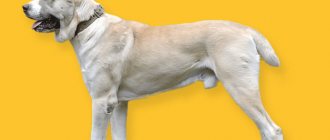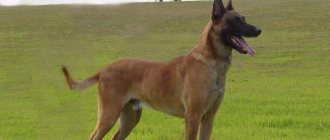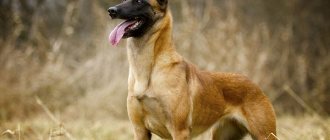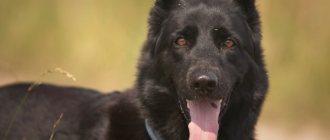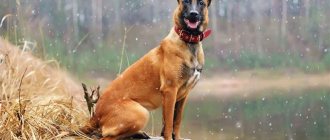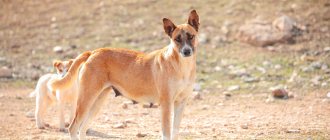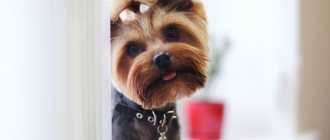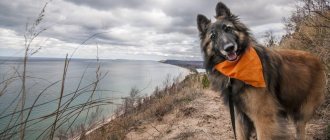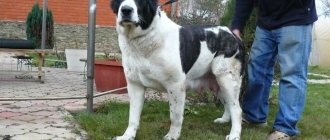The Belgian Shepherd section includes 4 varieties of the breed - Groenendael, Laekenois, Tervuren and Malinois (differing in color and coat length). They have a strong physique, elegant and at the same time powerful appearance. Their popularity is growing every year (about a thousand individuals already live in Moscow). Hardy, strong dogs need serious training. We do not recommend training a Malinois dog if you do not have the skills to handle a dominant, intelligent, independent animal.
Basic moments
- Belgian Shepherds are ideal watchdogs in every way. Dogs fearlessly protect the property entrusted to them and, if necessary, bark loudly.
- Representatives of the breed are famous for their mobility and therefore need regular active walks for at least one hour a day.
- The dog gets along well with other animals, but in the case of cats and small decorative rodents, problems can still arise.
- The Belgian Shepherd is quite suitable for a family with children, but do not expect the pet to enthusiastically participate in games.
- Dogs need early socialization and proper training, which is best done under the strict guidance of a professional.
- Belgian Shepherds are highly intelligent and amenable to training if the owner is strong enough in character.
- Of all the breed categories, only the Malinois does not require careful grooming.
- The Shepherd is not suitable for novice dog owners.
What kind of care does the Malinois breed require?
The key to the health of a pet of this breed is regular walks in an open area. An adult should walk or run up to seven kilometers a day. Life on a leash in a country house is absolutely not suitable for a Malinois. If the dog lives in an apartment, then keep in mind that walks should be frequent, at least two to three times a day, and the duration of the walk should not be less than two hours. This is a sociable breed, dogs need communication. With proper upbringing, they can be safely allowed near strangers. In addition, jogging and various types of activity have a beneficial effect on the bone strength and general tone of these animals.
Malinois training should include not just walking and forced marches, but also work on special areas with obstacles - so-called agility. Do not forget that you are becoming the owner of a dog with high intelligence and it also needs to be developed and trained. Stock up on a varied arsenal for games like frisbee: you can hide things familiar to your pet, invite him to perform certain manipulations with certain objects.
Caring for a Malinois at home does not require special skills. There is almost no smell from these dogs; attention should only be paid to the condition of the coat and skin. It is better to brush your pet a couple of times a week, despite the short fur, and if your four-legged friend sheds, then a little more often. There is no need to bathe Belgian Malinois; if absolutely necessary, it is enough to do it four times a year. The wool and undercoat cannot withstand frequent washing and deteriorate.
Monitor your pet's health. First of all, it must be vaccinated on time and dewormed regularly. At the very beginning of life, while still in the nursery, puppies undergo mandatory vaccinations so that they develop immunity to serious diseases. Such vaccinations do not differ between breeds. They are given at 1.5 months, then at 2, 7 and 12. The first vaccinations are complex and help develop immunity against plague, salmonellosis, influenza, and mumps. Next, you make sure that vaccination occurs every year. An equally important vaccination that must be done is the rabies vaccination. Those who travel abroad are well acquainted with the rules of rabies vaccination; without it, you simply will not be allowed to leave your homeland.
To confirm the presence of one or another vaccination in a dog, a special veterinary passport is created for each individual. In the column for each vaccination, enter the name of the vaccine and stick a label, and also put a stamp with the date. For all these procedures, the owner must go to a veterinary clinic; he cannot vaccinate himself.
At the same time, you can completely examine the dog yourself to rule out the presence of inflammatory processes in the eyes and ears, help brush its teeth with special devices and remove tartar. You should also inspect your pet’s fur; this is done more often during the warm season, since during these days ticks can hide in the folds of the dog’s skin. To prevent this problem, the dog is usually wearing a special anti-flea and anti-tick collar.
The Malinois diet is similar in composition to the diet of a person who adheres to the principles of a healthy diet. It should include meat - red and white (beef, chicken, rabbit), boiled fish (sea or river), chicken eggs, cereals, vegetables and fruits (raw and boiled). But even with an optimal balance of different foods, vitamin complexes need to be taken periodically, especially for young dogs. Make sure your food contains enough fluoride, calcium, iron, and zinc. If you prefer to buy ready-made food, use premium products, especially dry food. Experts have repeatedly said that cheap food can negatively affect the health of your pet's liver and intestines. The portion is calculated as standard - 20% of the dog’s total body weight. For adult shepherd dogs there may be two approaches to feeding, for puppies - more often, about three to four times a day.
pixabay.com/
History of the Belgian Shepherd breed
It would seem that the history of this shepherd dog should be rooted in antiquity.
And indeed: even in written sources of the 17th century there are references to four-legged assistants to shepherds who looked after numerous flocks. Thus, the first description of Belgian Shepherds (or at least dogs very similar to them) dates back to 1650. However, in fact, the breed is relatively young and has existed for just over a hundred years. How is this possible? This is all explained by the fact that in ancient times there were no people who would purposefully breed shepherd dogs. Moreover, the breed was not considered prestigious. Representatives of the European aristocracy did not bother creating kennel clubs, while their faithful preferred to keep representatives of other breeds as pets. The lion's share of shepherd breeding was done by peasants, who attached great importance to the working qualities of the dogs, and not to their attractive exterior.
By the second half of the 19th century, shepherd dogs were already distinguished by a huge palette of colors, but were still valued only for their purpose - the ability to herd a flock,, if necessary, gather sheep together and protect them from attacks by wild animals. The attitude of Belgian farmers towards these incredibly smart dogs was no exception. Everything changed with the beginning of the industrial revolution.
That moment was a turning point: Belgium's economy was being reinvented, and the accelerated pace of urbanization was forcing rural residents to move to larger cities. This had a negative impact on the popularity of herding dog breeds, which lost their importance.
The Belgian Shepherd owes its appearance to the wave of nationalism that swept Europe in the 19th century. At that time, many countries sought to create a breed of dog that would become their national treasure and be radically different from others. The end of September 1891 was marked by the creation in Brussels of the cynological organization BSDC - the Belgian Shepherd Lovers Club. In November of the same year, the first dog exhibition was held in the city of Kurgam, where more than a hundred animals were presented. Among the guests of the event was Professor Adolf Riyul, who studied dogs and in the future planned to introduce a specific breed for each region of Belgium.
Only a third of the shepherd dogs present at the exhibition were recommended by scientists for further breeding. Riyul selected medium-sized animals, without paying attention to the length and structure of the wool - only its quality mattered. In 1892, the professor introduced the world to the first standard of the Belgian Shepherd breed. The selection of dogs lasted about two decades. Initially, cynologists identified three varieties of the breed depending on color. This prompted dog breeders, whose wards did not correspond to any of the three categories, to create a separate canine circle and continue independent breeding of animals. The confrontation lasted for several years until the clubs merged and, as a consequence, the breed standard changed. To this day, it provides for four categories of dogs:
1. Groenendael – black in color with medium-length fur. They owe their name to a small village near Brussels.
2. Laekenois – ash-gray color with long hair. The breed variety is named after the historical district of Laeken in the north of the capital.
3. Malinois - charcoal or brown-yellow in color with short hair. They inherited the name from the town of Malina (Mechelen).
4. Tervuren – charcoal-red color with long hair. The name of this breed category comes from the city of Tervuren, 8 km from the capital.
Controversy regarding Belgian Shepherds continues to this day. Some breeders believe that these are different breeds of dogs, the Federation of Cynologists - that they are one and the same. In general, it is customary to adhere to the second point of view.
The next stage on the path to the formation of the breed was the appeal of the breeders to one of the largest cynological organizations of that time - the Royal Society of St. Hubert (RSSH). The application for breed recognition was rejected. It was only after the final modernization of standards in 1901 that the Belgian Shepherd was officially recognized and registered by members of the RSSH. For each of the four varieties, standards were formulated that primarily fixed the color and length of the coat.
Since the beginning of the 20th century, representatives of the breed were among the first to serve in the Belgian police. At the same time, shepherd dogs were used to patrol the borders of the state and catch smugglers. In 1907, Groenendaels appeared in the United States. A year later, representatives of the breed were already actively patrolling the streets of France.
During the First World War, Belgian Shepherds played an equally important role. Animals carried out responsible guard duty, served as military postmen, and helped pick up the wounded from the battlefield. It was at that time that people took a different look at the breed and saw important traits in it: courage, loyalty and strength. Gradually, Belgian Shepherds earned the love of the whole world. However, it is worth noting that the popularity of the breed is uneven. The most preferred are the Groenendael and Malinois.
Training at 4 - 5 months
By this time, the Malinois puppy has already become accustomed to your home and usual walking areas, and no longer needs your support and care so much. He begins to flirt with other dogs, pretend that he does not hear you when you call him, and show a certain persistence and disobedience when performing various commands.
This means it's time to move on to full training . In classes at this age you can already be persistent and demanding. At the same time, the most important thing is not to overdo it, remember that classes should bring joy to both you and your dog, and only then you can achieve the desired result.
Required commands in 4 months
What commands are practiced by a Malinois puppy at 4 months:
- Calm movement next
to the owner with and without a leash, with landing when stopping, with a change in pace and direction of movement - Return to you
on command - Exposure
in a free or certain position (sitting, lying, standing) - Indifferent attitude towards treats scattered on the ground
- Inhibitory command
to stop unwanted actions - Execution of a set of commands “sit”, “lie down”, “stand”
at a distance and near the leg, when giving commands by voice and gestures - Stop barking
on command.
Appearance of the Belgian Shepherd
The Belgian Shepherd is a large breed of dog. These animals look elegant and well-coordinated, despite their rather large dimensions. Thus, the height of males at the withers reaches 61-66 cm, while females usually grow to 56-61 cm.
The weight of Belgian Shepherds varies between 20-30 kg. Minor deviations from this standard are acceptable.
Head and skull
The dog's head is folded harmoniously, but at the same time it looks rather dry. Moderately lengthened, set high. The skull is proportional to the head in all respects. The animal's forehead is flattened and does not have a clearly defined midline. When the Belgian Shepherd's head is turned in profile, it becomes noticeable that the lines of the muzzle and forehead are parallel to each other. The cheekbones are poorly defined, but at the same time they are distinguished by well-developed muscles. The same applies to the brow ridges of the animal.
Muzzle
The shepherd's muzzle is not much longer than the skull and gradually tapers towards the end. Stop moderate. The nostrils are wide open, the nose has rich black pigmentation. Thin lips are pressed tightly to the jaws, the mucous membrane is characterized by the absence of pink areas.
Ears
Set high, they have an almost perfect triangular shape. Their tips are pointed, while the ears are smoothly rounded at the base. When the Belgian Shepherd is alarmed by something, its ears stand upright and straight.
Eyes
They are medium in size and almond-shaped. The pigmentation of the iris is brown, and the richer it is, the better. The eyelids are “rimmed” with black. Belgian Shepherds have a lively and inquisitive look, from which not a single important detail escapes.
Jaws and teeth
White teeth are densely recessed in well-developed jaws. The standard provides for scissor and level bites (the latter being less preferred, but increasingly being chosen by shepherds). The dental formula is complete. The absence of first premolars is not considered a defect.
Neck
The straight and rather elongated neck of the Belgian Shepherd is set high and is characterized by the absence of dewlap. It widens towards the shoulder blades and has a smoothly curved scruff.
Frame
The massive body of the animal does not look heavy and is distinguished by the observance of certain proportions. So, in males, the length of the body corresponds to the height; in bitches the first parameter may be slightly larger. The chest is moderately wide, but at the same time it is voluminous, like all dogs, which are characterized by excellent endurance. The ribs are smoothly curved. The pronounced withers merge into a straight topline. The abdomen is relatively tucked, the croup is located at a slight slope. The muscles are sculpted.
Tail
Medium length, has a wide base. In a calm state, the animal keeps its tail lowered, only the tip is slightly curved upward at the level of the hocks. In movement, the tail rises, without bending or taking the shape of a hook.
Forelegs
The shepherd's strong limbs have strong bones and well-developed muscles. The long shoulder blades and shoulders form a fairly wide angle for elbow movement. The forearms are surrounded by strong muscles. Short pasterns lead into rounded paws with curved and tightly clenched toes. Durable claws have rich dark pigmentation.
Hind limbs
Located perpendicular to the ground. The wide hips and lower legs are moderately muscled. Moreover, the latter are sufficiently curved towards the hock joints. The presence of dewclaws is undesirable. The paws have an almost oval shape due to compressed toes, which end in fleshy pads.
Movement style
The Belgian Shepherd is very active and has a habit of occupying significant space when moving. At the same time, due to its temperament, the dog does not adhere to the direct direction. The preferred pace is a calm walk and trot, less often a gallop. The movements are springy and lively.
Coat
Despite the existence of four categories of the breed, in all cases the dog’s coat is dense and thick. This is where the similarities between the Belgian Shepherd varieties end:
1. The Groenendael has a long, smooth coat with a thick undercoat that protects the dog from adverse weather. There is no glossy shine of the hairs.
2. Laekenois has a coat that is harsh and rough to the touch, and is often tousled. On the limbs and face of the animal, the fur is much shorter.
3. Malinois is a short-haired type of breed. Longer hair is acceptable around the animal's neck (where it forms a small collar from the ears to the throat), on the hips (feathers) and the tail.
4. The Tervuren is similar in type to the Groenendael, but the coat on the head and lower limbs is much shorter. Eyebrows, mustaches and beard are visible on the muzzle.
Color
The color of an animal depends on its belonging to one category or another:
1. Groenendael wool is a rich black color. In this case, white points may be present on the chest and fingers.
2. Laekenois has a reddish color interspersed with white. A darker shade of fur is acceptable on the face and tail.
3. Malinois are the owners of red-charcoal coat. The animal's muzzle and ears are framed by a black “mask”.
4. The color of the Tervuren is similar to the Malinois, but the dog's coat is as long as that of the Groenendael. The chest and toes may be marked with white.
Possible defects
A defect is any deviation from the breed standard. Among the most common:
- partial pigmentation of the eyelids, nose and lips;
- cowardly or aggressive behavior;
- weakened hock joints;
- light pigmentation of the iris;
- asymmetrical “mask” on the muzzle;
- lack of thick undercoat;
- slight underbite;
- hook-shaped tail;
- straight shoulders.
Disqualifying defects of Belgian Shepherds include:
- docked tail or lack thereof from birth;
- overly aggressive or cowardly character;
- white points on the body (except fingers and chest);
- artificially placed or drooping ears;
- pronounced overshot or undershot;
- absence of three premolars;
- cryptorchidism.
A Brief Overview of the Advantages and Disadvantages of Malinois Shepherd Dogs
The advantages of the Malinois breed include the following:
- By purchasing a Malinois puppy, you become the owner of a guard breed, this is genetically inherent in them;
- one of the main qualities of the Malinois is observation and caution;
- dogs of this breed are smart and sociable, they will certainly become your reliable companions and friends, and will invariably accompany you wherever you go;
- thanks to their high intelligence, Malinois are easy to train, they understand their owner literally, they serve faithfully and devotedly, and they are strict with strangers;
- These dogs are quite friendly towards children, although dog handlers warn that they should not be left alone with children;
- good trainability and caution make this breed indispensable as a service dog - experts recommend accepting them for service in the Ministry of Emergency Situations even more often than German shepherds;
- Malinois are very hardy, have excellent health and do not require special care.
Among the disadvantages of the breed, most of which, however, can be regarded as advantages, we highlight the following:
- Malinois is a very active dog that requires space and an active lifestyle; it can hardly tolerate being in closed spaces and needs frequent walks and training;
- dogs of this breed really need communication, so long separations from the owner are not for them;
- you should treat with great care the interaction of Malinois with small children: animals may accidentally miscalculate their strength and harm them;
- Malinois require constant training: not only physical, but also intellectual;
- These dogs shed twice a year, and in apartment conditions almost constantly, so it is necessary to care for their coat.
Personality of the Belgian Shepherd
The Belgian Shepherd is a very versatile breed due to the fact that each of the four categories has its own unique character. At first it is not noticeable. However, when interacting directly with Belgian Shepherds of all types, you will easily notice that they behave slightly differently, although in general they combine certain characteristics of each other.
The Groenendael is ideal for the role of a guard dog. Not a single offender will escape the shepherd's close attention, and she will notify those around her of whose appearance she will bark loudly. The feeling of fear or timidity towards strangers is not inherent in Groenendael. However, in the presence of a family, a shepherd dog is cautious and does not immediately develop trust in a person whom it sees for the first time in its life. Otherwise, the Groenendael is an active animal, which is famous for its tendency to patronize and take care of each member of its family. The ideal environment for this Belgian Shepherd will be people who prefer to lead an active lifestyle and thereby provide it with the opportunity to stretch its paws. Otherwise, the Groenendael will splash out the accumulated energy on its own - and not always in the right direction. Give your pet a game with a ball or frisbee, keep him busy practicing herding and searching skills - and your Belgian’s happiness will know no bounds!
Laekenois combines contradictory qualities: playfulness and seriousness, vigilance and detachment, the desire to move mountains and the desire to lie down at the feet of the owner. Like the Groenendael, this variety of Belgian Shepherd copes well with its guard duties and, if necessary, will enter into a fierce battle with the enemy, wanting to protect the owner. The Laekenois gets along well with other pets if it has been raised side by side with them. However, it is better to refrain from decorative rats, chinchillas, hamsters or parrots. As for pastime, Belgian Laekenois prefer active walks in the fresh air, during which it is necessary to give the animal certain physical activities.
The Malinois, like his brothers, needs regular “shake-up” to release pent-up energy. Otherwise, this is a completely balanced and obedient dog that will follow its owner’s heels and greedily catch his every word. The Belgian Malinois is not a pet that would prefer loneliness and a peaceful sleep in a remote corner of the apartment. The owner of a shepherd dog must pay it as much attention as possible, while remaining a strict but loving owner. However, the first may not be necessary: among all varieties of the breed, the Malinois has gained fame as the dog with the most docile character.
Tervuren, on the other hand, is known for his impulsive and lively temperament. It is noteworthy that initially these animals were distinguished by a timid and shy character, which was almost completely eradicated as a result of correct breeding selection. Belgian Tervurens actively react to any stimulus, so in the blink of an eye they get involved in a fun game with the owner or in pursuit of his offender. By the way, this shepherd experiences an extreme degree of affection only for one of the family members, so becoming this very person is your main task. Tervurens cannot stand loneliness and always try to compensate for it with torn slippers or a broken vase.
Among the common character traits inherent in all varieties of the breed, the following are distinguished:
- the dog’s ability to make decisions independently;
- sensitivity - the Belgian Shepherd reacts sharply to any critical remark of the owner;
- excellent adaptation to new conditions;
- tendency to dominate other animals.
How to train a Malinois
Training for this breed is a mandatory component. As already mentioned, without this, the character of pets may become uncontrollable. Choose a comfortable, spacious collar and, if necessary, a muzzle. If you resort to the services of a third-party assistant, then remember: a dog will develop good skills only with a calm, balanced person. Eliminate cruel punishments and physical influence; your pet is already smart enough. Malinois shepherd dogs are very sensitive to the mood of the owner, and this is worth taking advantage of. If you perform any tasks incorrectly, show resentment, then your pet will definitely try to fix everything. The set of exercises performed must be selected individually, based on the psychological and physiological capabilities of your Malinois. Be sure to take your dog out into the world to develop an optimal distance for him both with strangers and with his own relatives. A professional dog trainer will be able to recommend the most effective training program specifically for your pet.
Care and maintenance
Caring for a Belgian Shepherd is very labor-intensive, mainly due to the dog’s fur. Representatives of the breed shed twice a year - in summer and winter, so during this period it is necessary to comb the dog more thoroughly. The rest of the time, it is enough to repeat the procedure once or twice a week, depending on the age of the animal. However, it is not recommended to purchase a comb with fine teeth: these devices will not ensure gentle removal of dead hair. When combing your dog, move the comb slowly and in the direction of the fur: this will help avoid torn tufts.
Please note: Belgian Shepherd care varies depending on what category the dog falls into.
Groenendael is prone to very heavy shedding, so be prepared to find fur everywhere: on clothes, in bed and even on the kitchen table. During this period, you should brush your dog every day.
The Laekenois, the lucky owner of a curly coat, needs to be trimmed twice a year to keep the animal looking neat and well-groomed. For combing, it is better to purchase a massage brush with hard and sparse teeth.
Of all the types of Belgian Shepherds, the Malinois is the easiest to care for because its coat is short and smooth. Brush your pet once a week. This is enough to remove dead hair and give the dog a presentable appearance.
The Tervuren's double coat is prone to matting frequently, so it is recommended to brush your Shepherd at least twice a week. In addition, you will have to periodically trim the hair on the paws between the toes.
Try to bathe your Belgian Shepherd as rarely as possible: even special shampoos can cause the animal’s coat to lose its stiffness and pleasant dullness. If you think your pet smells like “dog,” use special products to eliminate the unpleasant odor.
Check your dog's eyes and ears regularly for discharge. To remove them, you need to use a cotton swab dipped in warm water or tea leaves. In case of infectious diseases, contact your veterinarian immediately.
Since the Belgian Shepherd spends a lot of time outdoors, its nails wear down on their own. In rare cases, you may need a nail clipper for large breeds. After shortening the nails, go over the sharp edges with a nail file to remove any nicks.
Caring for your pet's oral cavity is no less important. To brush your teeth, you need to purchase a special brush or finger attachment. It is strictly not recommended to use “human” toothpaste: hygiene products for dogs are sold in almost every pet store.
As for the Belgian Shepherd's diet, it should be varied. The full development of a dog is ensured by proteins of animal and plant origin. No less important are carbohydrates – your pet’s main source of energy. Fats also play a similar role. If you prefer to feed your dog natural food, you need to “dilute” it with a vitamin-mineral complex, without which the animal’s body will not function properly. Please also note that dry food is poorly absorbed by the shepherd’s digestive system and can cause bloating or cramping.
When feeding an animal, it is important to adhere to a certain regimen. Try to fill your pet’s bowl at a strictly set time - and you won’t have to feel like a callous person, ignoring the dog’s pitiful gaze aimed at the next treat.
You should not treat your Belgian Shepherd:
- river fish in any form;
- dairy products;
- raw meat and eggs;
- fruits with seeds;
- tubular bones;
- yeast dough;
- sweets;
- legumes
There should always be clean water in the animal's bowl, which must be changed regularly. It is not advisable to give water directly from the tap; let it brew for 6-8 hours.
Training at 3 months. Socialization
Three months is an important stage in a Malinois puppy’s introduction to the outside world. Your first walks should be short and not too tiring for the puppy. You should start with 15 minutes, gradually increasing the walking time to 1 hour.
Correct formation of the nervous system
At this age, the puppy’s nervous system is forming.
. It has been proven that raising puppies in isolation during this important period contributed to the development of pronounced cowardice in them later. It is necessary to show the puppy as much as possible: noisy streets, large crowds of people, etc. Everything that he will have to face in later life.
This must be done very carefully, gradually, over and over again increasing the time spent in noisy places, so as not to overload the puppy or frighten him.
The territory of a country house, cottage or village are places with a minimum amount of external stimuli for a city dog. Therefore, if you plan to keep a dog in an urban environment, “growing up” a Malinois puppy in such conditions depleted of irritants is unacceptable.
A city puppy must grow up in the city, in conditions that are saturated with external stimuli, such as: noisy streets, large crowds of people, other animals, birds, cyclists, cars, etc.
Meeting people and dogs
It is necessary to introduce the puppy to friendly dogs and people
so that later the puppy does not develop aggression or cowardice caused by the fear of new things and the inability to communicate and make new acquaintances. Currently, unfortunately, this is not uncommon in the behavior of adult dogs, but a fairly common problem with which people turn to our specialists for help.
Puppy behavior on the street
The emergence of new places leads to new rules that need to be consolidated:
- Now you can and should go to the toilet on the street, and not stoically endure it, carrying everything home;
- Not every new person or dog wants to communicate, so you don’t need to run headlong to meet everyone;
- Not all food is healthy, so it should only be taken from the owner’s hands.
Training and practicing commands
Training a puppy follows the same principles as at 2 months. It should be remembered that at this age puppies develop conditioned reflexes quite easily, but they are forgotten just as quickly, so you should not scold the puppy for not following commands, especially if they have not been repeated for a long time, but you should pay more attention to learning new things and repeating already covered material .
Belgian Shepherd Health and Diseases
The Belgian Shepherd has a strong immune system, which is maintained by timely vaccination of the animal and regular examinations by a veterinarian. However, some diseases are still more common than others. Among them are:
- deficiency of thyroid hormones;
- cramps and bloating;
- joint dysplasia;
- volvulus;
- epilepsy;
- cataract.
Belgian Shepherds are prone to obesity, so you should not overfeed your pet, no matter how tearfully he asks to fill the bowl.
Health
The Malinois is considered a naturally healthy dog. The average life expectancy is 12-14 years. There is a predisposition to certain diseases among representatives of the breed, but many problems can be avoided with proper care, feeding, and timely vaccination. It is also important to conduct regular preventive examinations at a veterinary clinic and treatment for parasites.
No matter how well you take care of your pet, some diseases cannot be prevented. The owner should know what health problems are most common in Malinois:
- Cataracts are an eye disease that can lead to vision loss.
- Joint dysplasia is characterized by severe pain and requires surgical intervention in the acute stage.
- Allergy - you need to detect the allergen and eliminate it. The allergen may be food or animal care products.
- Epilepsy – leads to convulsions, involuntary bowel movements. The disease can and should be controlled.
- Gastric volvulus is a serious condition and surgery is needed to save the animal.
- Obesity - occurs from poor nutrition and lack of exercise. Leads to metabolic disorders and other health problems.
It is important to ensure that the Malinois does not get injured. This dog is very active; he can get injured while jogging, jumping and other physical activities.
How to choose a puppy
Choosing a four-legged toddler is a responsible step, regardless of which breed you ultimately choose. First of all, ask the breeder to introduce you to the parents of the puppies. This will allow you to understand what qualities and character traits you can count on when taking a baby from this litter. Pay attention to the age of the puppies. Ideally, they are weaned from their mother at two months. By that time, the Belgian Shepherd has already formed a holistic picture of the world, and its mental health is beyond doubt.
Now you can start getting acquainted with the furry little ones. Look for the most active and lively one: he will definitely not cause you trouble, often getting sick or not wanting to take part in games and education. Excessive timidity and lethargic behavior should alert the potential owner of a Belgian Shepherd.
And finally: you should not buy a puppy at one of the bird markets, where they will certainly try to attract you at a low price. In the future, you will spend a lot more money traveling to the best veterinary clinics in the city.
Diseases characteristic of the Malinois breed
Malinois owners are incredibly lucky in terms of the genetics of their pets. These dogs have almost no hereditary diseases. Their immunity is strong and their health is enviable. Life expectancy under an average stress load is 10-15 years. The only troubles are injuries to the limbs and ligaments, because these dogs are very mobile and can incorrectly calculate the trajectory or danger and earn a bruise. In such cases, it is recommended to immediately consult a veterinarian.
And yet it is worthwhile to dwell separately on the possible diseases of the Malinois. Hereditary diseases include allergies (traditionally to the pollen of certain plants, less often to foods), eye diseases - retinal disorders, cataracts and blindness, various disorders of the thyroid gland, which, fortunately, are treatable, as well as epilepsy. If the rules of pet care are not followed and the feeding is improper, your Malinois may also have problems with the gastrointestinal tract. For the same reasons, your dog may develop dermatitis and excess weight. If the owner does not ensure proper distribution of the load during the dog’s physical activity, then problems with the joints, deformation of the limbs, and disruptions in the functioning of the heart and blood vessels are also guaranteed. And, of course, do not forget to pay attention to the psychological state of your pet.
Malinois dogs are ready for mating at 1.5-2 years of age. This process does not differ in any particular way among representatives of this breed. Readiness for mating occurs on the 15-20th day of estrus in females. In order for everything to happen harmoniously, you need to take into account some points. First of all, watch out for comfort during this period: mating should take place in the male’s territory, the dogs should not be disturbed, it is enough to just provide some assistance - for example, holding them, using improvised means like pillows. And, of course, you should make sure that the couple is healthy and vaccinated.
How much does a Belgian Shepherd cost?
This breed is notable for the fact that the price of a dog is determined not only by its class (show, breed or pet), but also by the variety to which the shepherd belongs. Belgian Groenendael puppies cost their future owners 25 thousand rubles and more. The price of a Malinois reaches 40 thousand, and a Tervuren – up to 60 thousand rubles. At the same time, Laekenois puppies require truly fabulous money: this is the least common type of Belgian Shepherd in Russia.
Prices vary depending on the region and the kennel where the dogs are bred, so do not despair: you will probably come across an offer that perfectly matches your expectations.
source www.lapkins.ru
What to look for when choosing Malinois puppies?
When choosing a Malinois puppy, contact proven and market-proven breeders. Tell us about your expectations from this dog breed. In a conversation with a representative of the nursery, many nuances can become clearer. They will tell you about the features of care and nutrition, recommend clinics and trainers, and introduce you to the parents and siblings of the proposed pet. Pedigree is very important in the selection process; this applies not only to the character, but also to possible hereditary diseases of the dog. The nursery must also provide you with a pet passport and a club card. And the most important moment is meeting the future family member, your Malinois. A healthy puppy will be active and curious, and its coat should be well-groomed and shiny. If events turn out differently, it’s worth thinking about it and asking additional questions. The cost of a Malinois puppy from a nursery ranges from 30,000 to 40,000 rubles. Owned dogs will cost you about half as much, but in this case you will have to accept all the possible risks of this situation.
pixabay.com/
Features of the view
The Belgian Shepherd dog combines working qualities:
- shepherd;
- assistant;
- defender;
- hunter;
- security guard;
- bloodhounds.
Thanks to these character traits, Belgians successfully serve in the police and army, and search for people, drugs and chemicals.
Belgian Shepherds, having a stable psyche, absolute obedience and professional flair, are often found at work in places of destruction and landslides after natural disasters and natural disasters. In emergency situations they show the best of their qualities. Also, service dogs include such breeds as: Rottweiler, Cane Corso, Boxer, Newfoundland, Black Terrier, St. Bernard, Giant Schnauzer, Doberman
This breed of dog is extremely hardy and tireless in work due to its medium size, developed muscles, body flexibility and speed of movement. It should be noted that dogs of this breed have extraordinary jumping ability; a three-meter barrier is not the limit that a Belgian can overcome. The listed qualities, combined with grace, phenomenal learning and training abilities, make these dogs regular participants in sports competitions and competitions.
It should be noted that these dogs are infinitely attached to their owner. In an emergency situation, if the owner is in danger, the Belgian Shepherd instantly turns from a calm and vigilant guard into a fearless beast, ready to protect the owner at any cost.
Important! It is strictly not recommended to keep a Belgian in an ordinary apartment.
The exception is when the owner leads an active lifestyle and is able to provide his pet with a sufficient amount of physical and mental exercise, which is very difficult in the cramped space of an apartment. Belgians are recommended for very active people whose professional activities are related to sports, service in the Ministry of Emergency Situations, police, army or customs.
Based on external features, there are four types of Belgians:
- Malinois - short coat, yellow-brown, red-brown or red;
- Tervuren - long coat, bright red or red-brown;
- Groenendael - long, fluffy, black coat;
- Laekenois has a hard coat, gray, red, fawn or red-brown.
Malinois is a type of Belgian Shepherd that is most widespread in the vastness of our homeland. And this is quite natural, since of all the types of Belgian Shepherds, the Malinois is the most efficient and hardy. These dogs have an amazing sense of smell and absolute fearlessness when protecting their owner. The Malinois's face is decorated with a black mask, as if drawn with charcoal.
The Tervuren is similar in appearance to the Groenendael, except for the color of its coat. The Tervuren has long, fawn or bright red fur with black hairs at the tips. The Tervuren is the largest of all Belgian species. This is an example of symmetry and grace. The dog is very mobile and active, dexterous and fast, it simply needs a large living space.
Thanks to its black color and long coat,
the Groenendael Such external attractiveness had a negative impact on the working characteristics, as breeders began to pay too much attention to shows and exhibitions to the detriment of the development of the working qualities of the breed. The result was a faithful companion dog, but not a service dog.
The Laekenois is the least common type of Belgian Shepherd in the world. The Laekenois's tousled, coarse coat, combined with its beard, mustache and eyebrows, gives it a terrier-like appearance. Due to the fact that too few puppies appeared in the litters, which received the external characteristics of the breed inherent in the Laekenois, frequent inbreeding was practiced. The dog turned out to be efficient, but vicious. As a result, Laekenois have the poorest health of all Belgian Shepherd varieties.
Photo and description
- Home country : Belgium.
- Breed recognition - FCI, UKC, AKS, KCGB, ANKS, SKS.
- The height at the withers of males is 60–66 cm, on average 62 cm.
- The weight of males is 25–30 kg.
- The height at the withers of females is 60–66 cm, on average 58 cm.
- Bitches weigh 20–25 kg.
- Life expectancy is 12–15 years.
- Contents : private house.
- Temperament - active.
- Color - dark fawn or red with blackening on the face and ears.
- The coat is short, close-lying, thick with a fluffy undercoat.
- The body is square, muscular, strong.
- Posture - proud with straight shoulders.
- Movements are a little mincing, fast and light.
- The head is set high.
- The eyes are dark brown, the look is intelligent.
- The ears are erect and triangular.
- The nose is black.
- The tail is thick and fluffy.
- Character - balanced, very active and vigilant. Suitable for keeping in a family.
- Training is easy.
- Accommodation - difficult to get along with other dogs, cats and domestic rabbits.
- The attitude towards children is positive if the dog grows up with the child.
Pet character
Malinois are very smart, intellectually developed, easy to train dogs, capable of making independent decisions. There is a need in the Malinois's character to develop these qualities. Peace and tranquility are not characteristics of the Belgian Shepherd. This breed is active, energetic and inquisitive. If this irrepressible energy is not channeled into a “peaceful channel”, or rather into useful work, then the pet will find entertainment that may not please the owner at all.
Important! If you don’t want to count the amount of damage that a Belgian Shepherd will definitely cause from boredom, keep it busy with something useful, physical or mental activity.
The Belgian is recommended for early socialization - you should accustom your pet to the company of people as early as possible. Otherwise, the animal may grow up suspicious, timid or even aggressive. The same thing can happen from lack of attention to the animal on the part of the owner.
These dogs have a confident, fearless character. They are suitable for an owner with an equally strong character, who can become an authority for his pet, otherwise the Malinois will take the role of leader in the family. But you cannot physically punish or raise your voice at a dog, since this breed has a delicate nervous organization. And yet, you need to raise your pet with strictness, but not excessively, so that it does not turn into cruelty.
Malinois are very attentive; by gestures and facial expressions they are able to detect the slightest changes in the owner’s mood. If the owner is upset or offended and refuses to communicate with his pet, this will be the worst punishment for a devoted dog. Most often, the Belgian chooses one owner, but with the rest of the family he will behave obediently. Malinois are quite patient with children, but you should still explain to the child that this is not a toy, you should not bother the dog or run around and wave your arms, so that the hunting instinct, which is well developed in the animal, does not suddenly work.
Dogs of this breed love and protect their family very much. The relationship between the Malinois and other animals is not easy, this applies to both dogs and cats. Belgian Shepherds love to chase cats, catch up with cyclists and passing cars.
In addition to serious responsible service, the Belgian Shepherd has proven itself well as a guard of a house or fenced area, as a companion for morning jogging, and as a guide dog for blind people. Malinois love to travel with their owner, run, play with a ball and frisbee.
It is better to keep the Belgian Shepherd in an outdoor enclosure, especially since representatives of this breed are adapted to changeable climatic conditions and adverse atmospheric conditions.
Nutritional Features
Despite the fact that Belgians are not picky about food, without a high-quality balanced diet they will not have a thick coat with fluffy undercoat, strong developed bones, and the main working character traits will not fully develop.
Owners of Belgian Shepherds can be divided into two camps: some are staunch supporters of dry food, while others are supporters of natural food.
With dry food everything is extremely simple and clear:
- Balance. The packaging indicates the composition and nutritional value of the food. It is very difficult to determine whether a Belgian’s natural diet contains enough macro- and microelements necessary for the body, as well as proteins, fats and carbohydrates.
- Possibility of choosing food according to the needs of a particular animal. The packaging indicates the purpose and compliance with the gender, age and degree of physical activity of the animal (food is developed separately for adult males, lactating females or puppies).
- Price. Even the most expensive dry food will be cheaper than high-quality, varied natural food, which will contain the required amount of meat, fish, etc.
- Save time. Feeding a pet with dry food requires virtually no time or effort from the owner. All that is required is to pour the food into a bowl and add water.
Despite all the above advantages of dry food, properly organized natural nutrition will be much healthier than dry food. Moreover, you cannot always trust what is written on the packaging of animal food.
A Belgian's natural diet should contain high-quality meat, sea fish, eggs, vegetables, dairy products and cereals from a variety of cereals. The most preferred porridges are buckwheat, pearl barley, rice, and wheat. The shepherd's diet should contain butter and vegetable oil. Sometimes you can give your pet seasonal fruits, and if necessary, add vitamins to the diet.
Find out more about the types of dog food such as: “Pronature”, “1st CHOICE”, “Pedigree”, “Grandorf”. And also read the rating of super-premium and premium food
If your Belgian trains a lot, you should feed him twice a day at the same time.
Education and training
Both the owner and the dog handler can train the pet. The Belgian Shepherd quickly copes and remembers the basic course. Dog handlers recommend that the animal undergo primary training, obedience and protection courses. And also the dog can easily cope and learn the skills of agility and the “Nippers” program.
All this will bring the puppy into good physical shape, speed up the animal’s reaction, and discipline it. With constant training, the dog's endurance increases and its service qualities develop. Before starting classes, the owner must give the dog handler a description of the dog so that he, based on its qualities, can select a training program suitable for a particular animal.
Breed characteristics
| Short description | |
| Origin: | Belgium |
| Conditions of detention: | In a house without a garden, in a house with a plot, in an apartment (with regular walking) |
| Purpose: | Guard dog, companion dog, herding dog |
| Color: | Redhead with charcoal and black mask |
| Wool length: | Short |
| Adult dog size: | The height of females is 56-62 cm, males 60-62 cm, weight of males is approximately 25-30 kg, females - 20-25 kg |
| Average life expectancy: | 10-14 years |
| Walk: | Mandatory walk 2-3 times a day |
| Physical activity needs: | High physical activity needs (regular or daily exercise for more than 3 hours per day) |
| Fédération Cynologique Internationale (FIC) classification: | Group 1: herding and cattle dogs, Section 1: shepherd dogs |
| Puppy price: | From 15,000 to 40,000 rubles |
Malinois - differences from the German Shepherd
- Appearance. The Belgian Shepherd has a leaner build and lighter weight. “Germans” are distinguished by their massiveness and large heads. The Malinois has a red coat and a black “mask”. The color of the German Shepherd is black or black and tan, with red or gray spots.
- Physical activity. Malinois accelerate and run faster than German Shepherds. "Belgians" have greater maneuverability, mobility and jumping ability.
- Nervous system. The German Shepherd has an inert temperament. The Malinois has a low threshold of excitability and can react violently even to minor stimuli.
- If improperly trained, the Belgian Shepherd becomes hyperexcitable, nervous and aggressive. Malinois relentlessly follow their owner and love tactile contact with him. The “German” is more restrained in demonstrating his affection for a specific person.
Pros and cons of the breed
The Malinois is a serious breed that requires supervision from the owner. Such a dog is not recommended for inexperienced people who lead a sedentary lifestyle and do not have the opportunity to devote a lot of time to their pet. So if you like a Belgian Shepherd, think carefully about whether you can provide her with decent maintenance. To make the right decision, check out the main pros and cons of the Malinois breed.
Advantages:
1. Exceptional intelligence, intelligence and intelligence. 2. Devotion. 3. High performance, endurance. 4. Good health. 5. Security and guard qualities. 6. No desire for dominance, adequacy. 7. Easily trainable.


